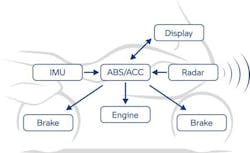This article appeared in eeNews Automotive and has been published here with permission.
Until now, motorcyclists have had to do without a comfort and safety assistance system that has been standard in cars (and in trucks) for many years—namely adaptive cruise control (ACC), the radar-based speed control system for rolling along in traffic. BMW now wants to introduce this technology to the world of motorcycles.
Together with Bosch, BMW has developed an ACC for motorcycles. Incidentally, BMW calls the system "active cruise control" rather than "adaptive cruise control." The result—and the abbreviation—remains the same.
With its ACC, BMW is primarily targeting discerning touring riders who want to offer a special level of comfort. The system enables automatic regulation of the driver's desired driving speed and the distance to the vehicle in front. When the distance to the vehicle in front is reduced, it automatically regulates the driving speed and restores the distance defined by the driver. The distance can be varied in three stages. Both the driving speed and the distance to the vehicle in front can be conveniently adjusted using a button; individual settings are displayed in the TFT instrument combination.
The new BMW Motorrad ACC has two selectable characteristics for the control behavior: comfortable or dynamic, whereby acceleration and deceleration are each influenced differently. Distance control can also be deactivated, enabling dynamic cruise control (DCC) to be used.
When cornering, ACC automatically reduces the speed when necessary and aims for a comfortable lean angle. In addition, motorcycle ACC also takes the lean angle into account when cornering. As the lean angle increases, braking and acceleration dynamics are limited to maintain stable handling and not unsettle the rider by abrupt braking or acceleration. The driver can intervene himself at any time. This is also necessary because BMW Motorrad ACC only reacts to moving vehicles. Vehicles that are stationary—for example, at the end of a traffic jam or at traffic lights—aren't taken into account. Here the rider must brake himself/herself.
BMW didn't announce when the new rider assistance system would be available. When asked, a spokesperson indicated that it would probably be included in the new models to be presented during the fall season.

